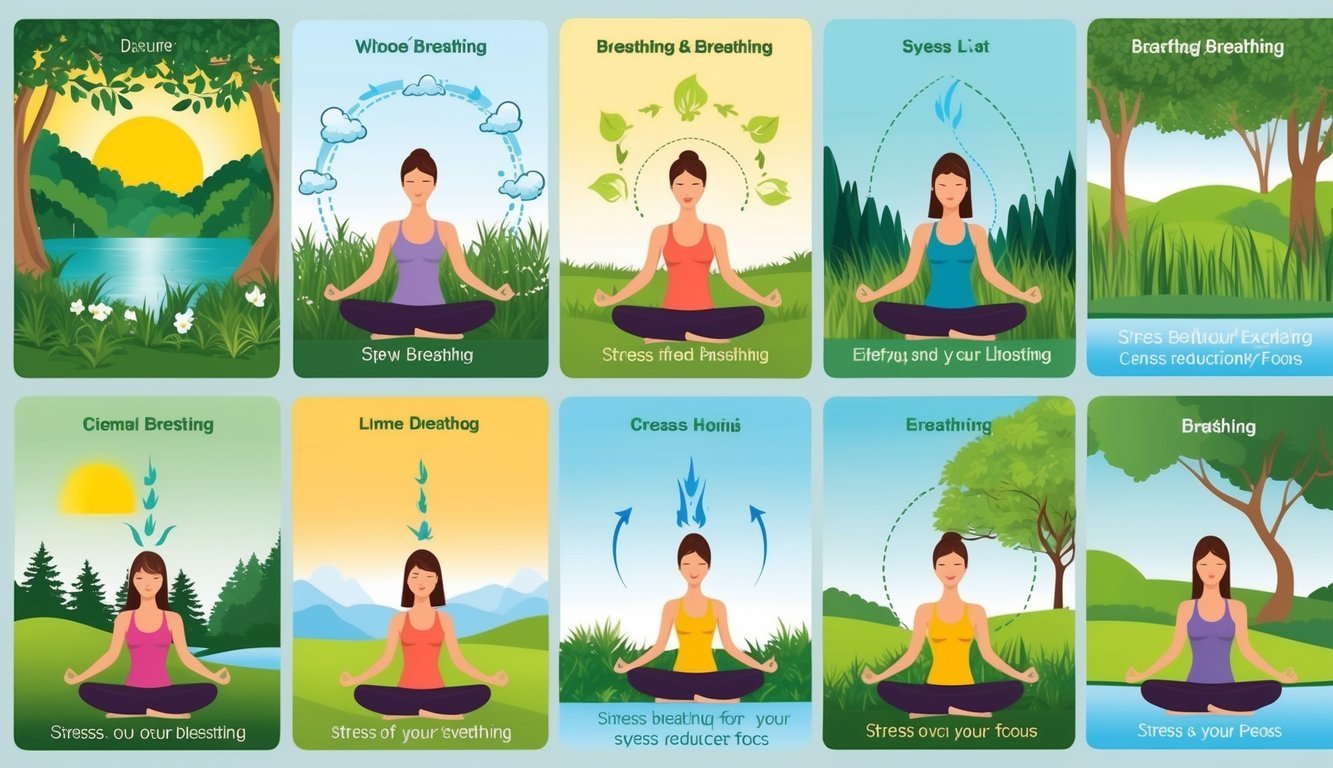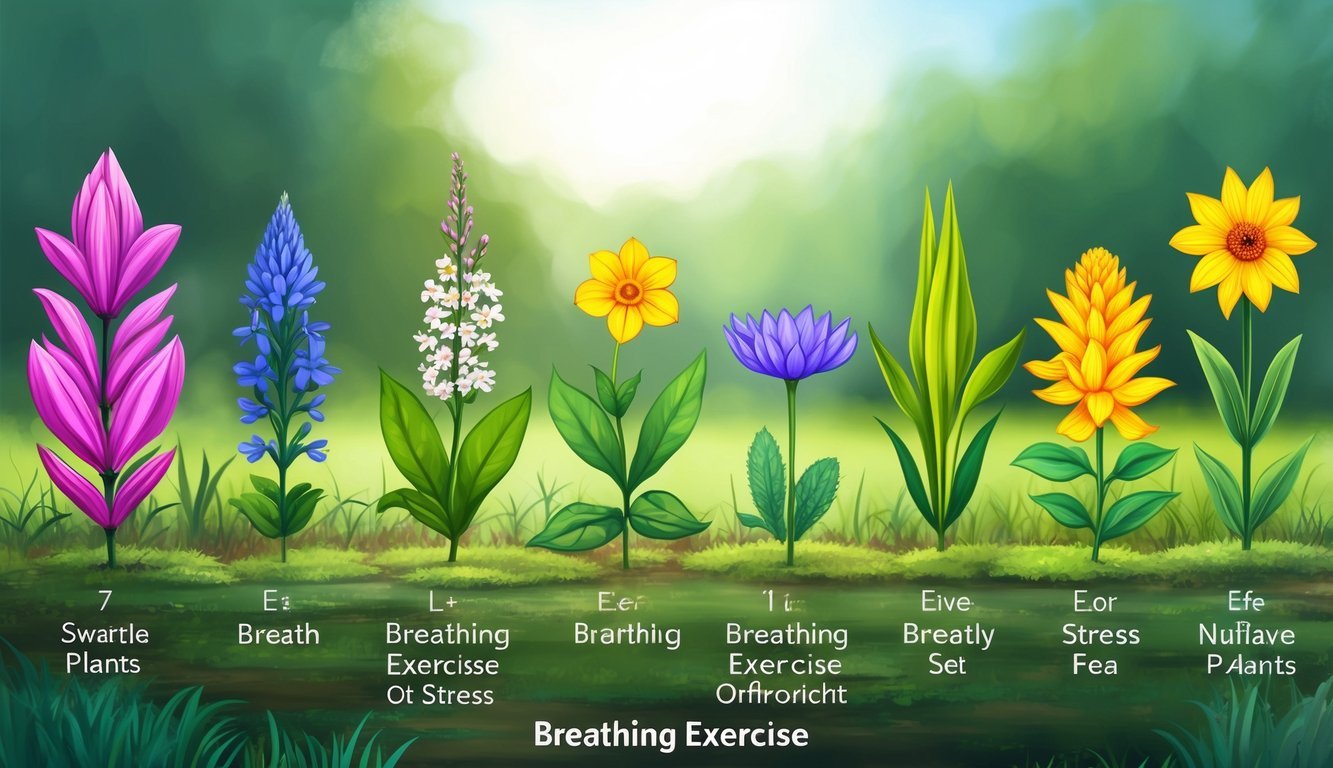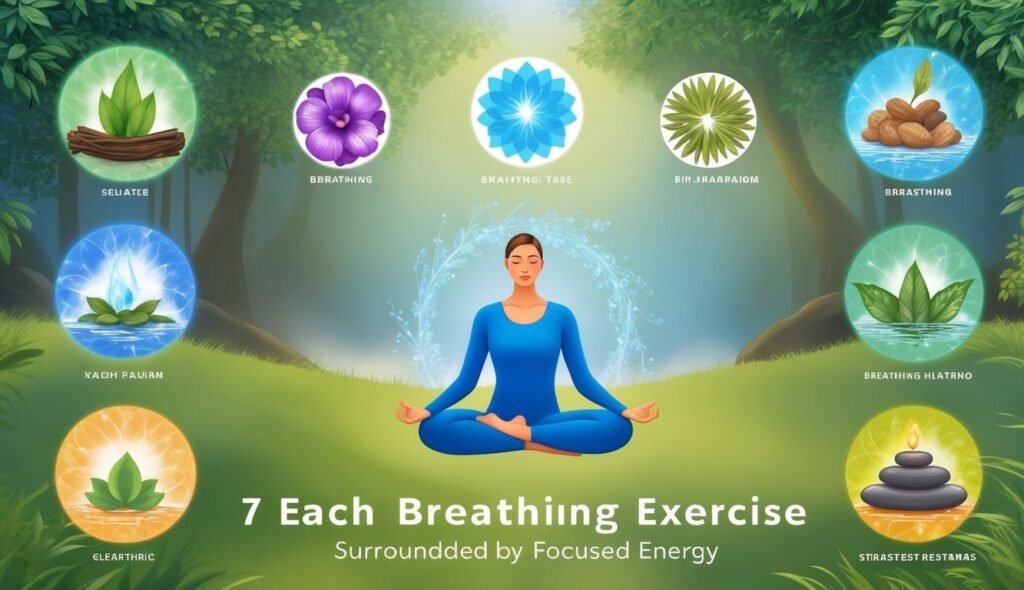Feeling stressed and need a way to relax? You’re not alone.
With busy schedules and constant demands, it can be tough to find calm.
Breathing exercises are simple yet powerful tools to help reduce stress and improve focus.

Learning the right techniques can make a noticeable difference in how you handle daily pressures. Whether you’re at work, home, or on the go, these exercises can fit into any part of your routine.
Dive into the possibilities of finding peace through your breath.
1) Diaphragmatic Breathing

Diaphragmatic breathing, also known as belly breathing, is a simple technique that can help calm your mind and body.
It involves deep, slow breaths that fully engage your diaphragm, a muscle located just below your lungs.
Focus on taking air into your belly rather than your chest.
This method helps slow your heart rate and reduce stress.
When you take a full breath, you can feel your abdomen rise.
Practicing diaphragmatic breathing can sharpen your concentration and reduce negative emotions.
It’s known to be a go-to for many people looking to relax.
Studies have shown its effectiveness in lowering stress levels and improving focus.
If you want to try it, find a quiet space, sit comfortably, and place your hand on your stomach.
Breathe in deeply through your nose, letting your belly fill with air.
Exhale slowly through your mouth.
Doing this exercise for a few minutes each day can make a big difference in how you feel.
2) 4-7-8 Breathing Technique
The 4-7-8 breathing technique is a simple and effective way to help you relax and reduce stress.
It involves breathing in for four seconds, holding your breath for seven seconds, and then exhaling slowly for eight seconds.
This method can be practiced anywhere and anytime you need to calm down.
By focusing on your breath, it can help increase your concentration and improve your mood.
Research shows that the 4-7-8 method may help reduce insomnia, pain, and anxiety among patients, including those with burn injuries.
This technique is also noted for providing relief from postoperative orthopedic pain.
Some people might feel lightheaded when they first try it, so it’s a good idea to sit down when you practice.
Over time, this technique can become a go-to tool for managing stress.
3) Box Breathing
Box breathing is a simple and effective technique to reduce stress and improve focus.
It’s really easy to do, which makes it a great option when you need some quick relief.
You can practice it anywhere, whether you’re at work, at home, or even stuck in traffic.
To start, find a comfortable spot and sit up straight.
Close your eyes if it feels right.
Begin by breathing in slowly through your nose for a count of four.
Make sure you’re filling your lungs and noticing the breath.
Hold your breath for another count of four.
Keep calm and focused as you hold.
Next, exhale slowly through your mouth for four counts, letting all the air out.
Finally, pause with empty lungs for a last count of four.
Repeat this process for a few minutes or until you feel more relaxed.
Box breathing can help manage stress and clear your mind.
Plus, it doesn’t take long, so you can fit it into your day easily.
Practice regularly to see the best results.
You might be surprised at how much it helps.
4) Alternate Nostril Breathing
Alternate nostril breathing helps you relax and find focus.
It’s a technique from yoga, often called Anuloma Viloma.
This practice involves breathing through one nostril at a time.
To start, sit comfortably and use your thumb to close one nostril.
Inhale deeply through the open nostril.
Close that nostril with your ring finger, then exhale through the other nostril.
This breathing exercise can help you feel calmer.
It balances the left and right sides of your brain, improving concentration.
Studies show it can also help reduce stress levels and improve sleep quality.
Nursing students found it helpful for managing fatigue.
It takes just a few minutes a day.
Try adding it to your routine whenever you need a break.
It’s a simple, yet effective way to reset your mind and body.
5) Resonant Breathing

Resonant breathing is a powerful exercise to help you calm down and improve focus.
It involves breathing at a specific rate that creates harmony between your heart and lungs.
This steady pace can lower stress and anxiety levels.
You’ll want to breathe at a slow rate, usually between 4.5 to 7 breaths per minute.
This can feel a bit odd at first, but with practice, you’ll find it becomes more natural and comfortable.
It can help balance your emotions and bring mental clarity.
Research shows that resonant frequency breathing can enhance heart rate variability, which is a measure of how well your body responds to stress.
This technique can be especially beneficial for young adults, supporting both emotional and cognitive functions.
Try setting aside a few minutes daily to practice resonant breathing.
It’s easy to incorporate it into your routine, whether during a break at work or before going to bed.
Over time, it may improve your concentration and overall emotional balance.
6) Pursed Lip Breathing
Pursed lip breathing is a simple yet effective technique that helps you breathe more deeply.
You can do it by inhaling through your nose and exhaling slowly through pursed lips, like you’re blowing out a candle.
This slows down your breathing and helps you feel more relaxed.
This technique is especially helpful when you’re feeling stressed or anxious.
It encourages more controlled breathing and can enhance focus.
Many people with chronic obstructive pulmonary disease (COPD) use it to manage their symptoms by lengthening exhalation and improving oxygen exchange.
You can practice pursed lip breathing anywhere.
Whether you’re at your desk or lying in bed, it’s very versatile.
Regular practice may improve how you feel throughout the day.
If you’re looking for an easy way to manage stress, this could be a great option to try.
Plus, you don’t need any fancy equipment or a special setting to do it.
Guided Visualization Breathing

Guided Visualization Breathing is a simple way to calm your mind and body.
It combines deep breathing with imagination.
You visualize peaceful scenes while focusing on your breath.
This exercise can help reduce stress and improve concentration.
To start, find a comfortable spot where you won’t be disturbed.
Close your eyes and take a deep breath in through your nose.
Hold it for a moment, then slowly exhale through your mouth.
As you breathe, imagine a relaxing place—like a beach or a forest.
Focus on the details of your visualization.
Picture the colors, sounds, and scents surrounding you.
As you continue to breathe, let any tension or stress melt away.
Your mind and body may begin to feel more relaxed and at ease.
Practicing this technique regularly can have positive effects on your well-being.
It can help you feel more present and less overwhelmed by daily stress.
This method is often used for stress management and to promote relaxation.
This practice is versatile and can be done almost anywhere.
Try it next time you need a quick mental escape.
Understanding Stress and Focus

Stress and focus are tightly linked with your breathing.
When you understand this connection, managing stress and improving concentration become more achievable.
How Stress Affects Breathing
Stress triggers a reaction in your body known as the fight-or-flight response.
During stressful moments, your breathing may become rapid and shallow.
This is because your body perceives a threat and tries to take in more oxygen quickly.
Such breathing patterns, however, can make you feel even more anxious and uneasy.
This affects your overall well-being, as your body doesn’t get the deep, calming breaths it needs.
You might feel tense, with racing thoughts and heightened alertness.
Understanding this connection helps you recognize when stress impacts your breathing, enabling you to take steps to calm down.
The Connection Between Focus and Breathing
Breathing deeply can play a pivotal role in improving your focus.
When you breathe slowly and deeply, you increase oxygen levels in your brain.
This helps clear your mind and provides the clarity needed to concentrate on tasks.
By focusing on your breath, you can keep distractions at bay, allowing your brain to hone in on what’s important.
This method acts almost like a reset button, helping realign your mind with the goals you want to achieve.
Employing this technique regularly can sharpen your attention, reduce scatterbrained moments, and improve productivity over time.
Why Breathing Exercises Help

Breathing exercises can do wonders for managing stress and improving focus.
They offer you practical tools to feel calm and stay alert in your daily life.
This section explores their benefits for reducing stress and helping you concentrate better.
By practicing these techniques regularly, you can develop healthy lungs strategies that support both relaxation and mental clarity.
Deep breathing not only enhances oxygen flow but also promotes overall well-being by reducing tension.
Incorporating these exercises into your routine can make a significant difference in how you handle daily challenges.
Benefits for Stress Reduction
Breathing exercises can significantly reduce stress by activating the parasympathetic nervous system, which helps you relax.
When you’re stressed, your body goes into fight-or-flight mode, triggering physical reactions like a faster heartbeat.
Controlled breathing can reverse this, bringing calmness.
A common method is deep breathing, which lowers cortisol levels, the hormone related to stress.
As you take slow, deep breaths, your heart rate slows, and tension decreases.
Such techniques are easy to use anytime.
You can practice them at your desk, while walking, or even lying in bed.
Regular practice helps you manage reactions to stressful situations.
Enhancing Concentration Through Breathing
You can improve your concentration by practicing focused breathing exercises.
These techniques increase oxygen flow to your brain, boosting alertness and mental clarity.
Simple practices like counting your breaths can sharpen your focus over time.
Mindful breathing exercises are particularly effective.
They involve paying attention to the natural rhythm of your breath.
This trains your mind to maintain focus on single tasks, rather than jumping from thought to thought.
These exercises also help improve memory by increasing the brain’s ability to process information.
By regularly practicing, you can boost your cognitive performance in learning, studying, or handling detail-oriented tasks.
They make it easier for you to stay present and attentive.

